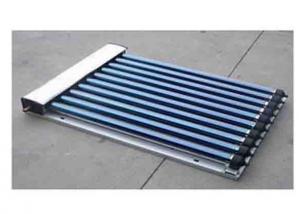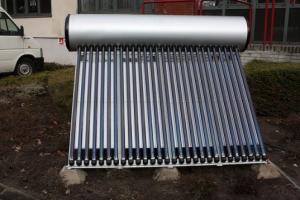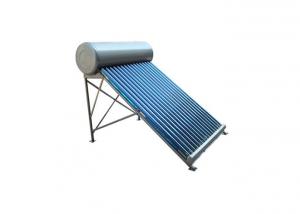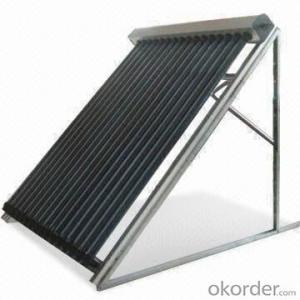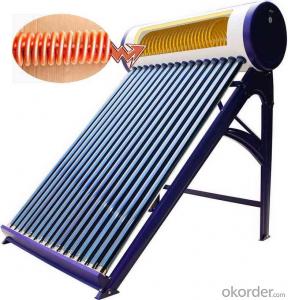Vacuum Tube Solar Collectors with Good Quality
- Loading Port:
- China main port
- Payment Terms:
- TT OR LC
- Min Order Qty:
- 5 set
- Supply Capability:
- 10000 set/month
OKorder Service Pledge
OKorder Financial Service
You Might Also Like
Specifications
manifold (inner) | red copper |
manifold (exterior) | aluminum alloy |
glass tube dimensions | 58mm * 1800mm |
daily efficiency | ≥55% |
heat preservation | 72 hours |
hail resistance | 25mm |
max pressure | 7 bar |
coating of vacuum tube | ALN/AIN-SS/CU |
heat pipe | anti-freezing > -35 degree |
certificate | Solar Keymark, EN12975,SRCC |
Serious Product
Models | L*W*H mm | Vacuum tube | Power output | Efficiency | Header mm | Frame | container loading 20FT/40HQ sets | Gross Weight kg |
SHC-8 | 1917*910*133 | 58*1800*8pcs | 939W | 0.668 | Φ35/1.0 | AL alloy | 185/445 | 27 |
SHC-10 | 1917*1130*133 | 58*1800*10pcs | 1189W | 159/385 | 33 | |||
SHC-12 | 1917*1350*133 | 58*1800*12pcs | 1440W | 149/358 | 40 | |||
SHC-15 | 1917*1680*133 | 58*1800*15pcs | 1815W | 120/290 | 49 | |||
SHC-18 | 1917*2010*133 | 58*1800*18pcs | 2191W | 100/242 | 59 | |||
SHC-20 | 1917*2230*133 | 58*1800*20pcs | 2442W | 87/210 | 66 | |||
SHC-22 | 1917*2450*133 | 58*1800*22pcs | 2692W | 83/202 | 72 | |||
SHC-24 | 1917*2670*133 | 58*1800*24pcs | 2943W | 77/188 | 79 |
Packaging & Delivery
Packaging Details: | Exporting Carton with big foaming protection |
Delivery Detail: | In 10-15 days |
Loading Quantity
Model | Tube | Tube Q.T.Y | Loading Q.T.Y/40HQ |
GSC15 | 58*1800mm | 15pcs | 315sets |
GSC18 | 58*1800mm | 18pcs | 265sets |
GSC20 | 58*1800mm | 20pcs | 248sets |
GSC22 | 58*1800mm | 22pcs | 225sets |
GSC25 | 58*1800mm | 25pcs | 200sets |
GSC30 | 58*1800mm | 30pcs | 168sets |
Principle of solar collector:


Solar collector details


- Q: Can solar collectors be used in telecommunications infrastructure?
- Yes, solar collectors can be used in telecommunications infrastructure. Solar collectors can generate electricity from sunlight, which can be used to power various telecommunication equipment such as mobile towers, repeaters, and satellite communication systems. This renewable energy source can provide a reliable and sustainable power supply to remote or off-grid telecommunication installations, reducing the reliance on traditional energy sources and minimizing operational costs. Additionally, solar collectors can be easily installed in various locations, making them a viable option for expanding telecommunication networks to areas with limited access to electricity.
- Q: Are solar collectors suitable for heating restaurants?
- Yes, solar collectors are suitable for heating restaurants. They can provide a cost-effective and sustainable solution for heating needs, especially in regions with abundant sunlight. Solar collectors can efficiently capture solar energy to heat water or air, which can then be used for various heating applications in restaurants such as space heating, hot water supply, and even cooking. By utilizing solar energy, restaurants can reduce their reliance on traditional fossil fuel-based heating systems, lower energy costs, and contribute to environmental sustainability.
- Q: Can solar collectors be used for heating car storage facilities?
- Yes, solar collectors can be used for heating car storage facilities. Solar collectors, such as solar thermal panels or air collectors, can absorb sunlight and convert it into heat energy. This heat energy can then be used to warm up car storage facilities, providing a cost-effective and environmentally friendly heating solution.
- Q: Can solar collectors be used for heating oil and gas facilities?
- Yes, solar collectors can be used for heating oil and gas facilities. Solar thermal systems can harness the sun's energy to provide heat for various industrial processes, including heating oil and gas facilities. This can help reduce reliance on traditional fossil fuel-based heating methods, leading to cost savings and a more sustainable energy solution.
- Q: Are solar collectors suitable for heating large indoor spaces?
- Yes, solar collectors can be suitable for heating large indoor spaces. By harnessing the power of the sun, solar collectors can generate significant amounts of heat energy, which can be used to warm up large areas. This renewable energy source offers an eco-friendly and cost-effective solution for heating purposes in indoor spaces. However, the efficiency and effectiveness may vary depending on factors such as climate, size of the collectors, insulation of the space, and energy requirements.
- Q: Can solar collectors be used for heating poultry farms?
- Yes, solar collectors can be used for heating poultry farms. Solar thermal systems can provide heat for poultry farms by capturing sunlight and converting it into heat energy. This can help maintain optimal temperatures inside the poultry houses, ensuring the well-being and productivity of the birds.
- Q: What is the lifespan of the absorber coating in a solar collector?
- The lifespan of the absorber coating in a solar collector can vary depending on various factors such as the quality of the coating, maintenance practices, and environmental conditions. However, typically, a well-maintained absorber coating can last for around 10 to 20 years before needing replacement or refurbishment.
- Q: Can solar collectors be used for heating residential buildings?
- Yes, solar collectors can be used for heating residential buildings. Solar thermal collectors, also known as solar water heaters, capture sunlight and convert it into heat energy, which can then be used for space heating or domestic hot water purposes in residential buildings. This renewable energy source is environmentally friendly and can help reduce reliance on fossil fuels for heating.
- Q: Are solar collectors suitable for heating museums and art galleries?
- Yes, solar collectors are suitable for heating museums and art galleries. Solar thermal collectors can efficiently harness the sun's energy to provide heating for these spaces. They can provide a consistent and sustainable source of heat, ensuring the preservation of delicate artwork and artifacts while also reducing energy costs and carbon emissions. Additionally, solar collectors can be seamlessly integrated into the architectural design of museums and art galleries, making them a viable and aesthetically pleasing heating solution.
- Q: What is the impact of dust and dirt on solar collector efficiency?
- Dust and dirt have a significant impact on the efficiency of solar collectors. When dust and dirt accumulate on the surface of the collectors, they block the sunlight from reaching the photovoltaic cells or the heat-absorbing surfaces. This reduces the overall efficiency of the solar collector system as less sunlight is absorbed or converted into electricity. Regular cleaning and maintenance of the collectors are essential to ensure their optimal performance and maximize energy production.
Send your message to us
Vacuum Tube Solar Collectors with Good Quality
- Loading Port:
- China main port
- Payment Terms:
- TT OR LC
- Min Order Qty:
- 5 set
- Supply Capability:
- 10000 set/month
OKorder Service Pledge
OKorder Financial Service
Similar products
Hot products
Hot Searches














